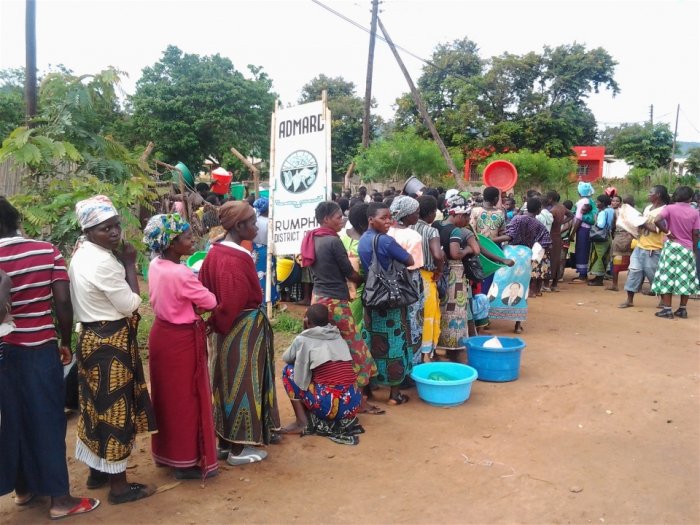Despite claims of the availability of maize in Agricultural Development and Marketing Corporation (Admarc) warehouses, the public grain marketer is failing to supply the staple grain to most markets across the country.
The development has resulted in starvation among poor buyers across the country as they cannot afford high maize prices prevailing in the local markets.
Government, through Admarc, bought 30,000 metric tonnes of maize from neighboring Zambia, in addition to 25,000 metric tonnes procured from the local market last year. A snap survey conducted in some districts and three major cities of the country, shows that an average of 700 bags of maize Admarc is supplying to each of its satellite depots per week just last few hours after delivery, forcing waiting consumers into scrambles.
“I prefer buying a 50 kilogramme bag of maize flour at K15, 000, rather than buying a 50 kilogramme bag of maize at K11, 000 or more,” said Esnart Phiri.
Phiri, who resides in Bangwe Township in the commercial city, said since Admarc opened its markets last year, she has never had an opportunity to buy the grain due to the long queues.
In other areas, however, there were allegations that vendors were employing people to buy more maize than the maximum 20kg each buyer is allowed to get. But Admarc officers said they are not aware of such arrangements.
In the Northern Region, some Admarc satellite markets in Mzuzu such as Masasa, Msongwe and the main market had maize when visited.
But at the main Admarc market, sources said there was no maize. Only staff members were spotted and there were no people buying the grain.
At Masasa, sources said the maize had come yesterday after a two-week break.
The sources said each satellite depot gets about a hundred 50 kilogramme bags each but do not last a day and, in some cases, staff prioritizes selling fertilizer.
However, maize is readily available on the parallel market in Mzuzu City. For example, at Zigwagwa Market, vendors sell the commodity at K3,800 per 20-litre bucket, K3,600 for an 18-litre bucket, K1,600 for an 8-litre bucket and K1,000 for a 5-litre bucket.
In Lilongwe, random spot-checks in several Admarc depots showed general scarcity of maize stocks.
Visiting several depots yesterday revealed a sad picture that showed that private traders are using tricks to buy maize at the expense of needy Malawians.
There was a long queue at Masintha in Kawale when visited, which saw people struggling to purchase maize.
An Admarc official, who refused to be named, said as of yesterday evening, the depot had six hundred 50kg bags.
“The maize isn’t adequate and it’s always erratic, but we need it considering the population of this area. What is also worrisome is the fact that it is taking a long time for the maize to come,” he said.
But a resident of Kawale, Rachel Joshua, differed with the Admarc official, saying the problem is that the little maize available is being sold to vendors who in turn are selling it at exorbitant prices.
A similar situation was at Lumbadzi Admarc Depot where people were turned away due to non-availability of the staple.
Rosemary Mandala, who had travelled 11 kilometres to buy the maize, said a security guard at the depot informed them that maize sales had been suspended because they had run out of stationery.
But Admarc Chief Executive Officer, Foster Mulumbe, and Minister of Agriculture, Irrigation and Water Development, Allan Chiyembekeza, said people should always call Admarc, the Minister, or Secretary for Agriculture to alert them if there is any need.
“The only problem is that we are only targeting permanent Admarc markets, not fixed markets because to operate a single fixed market it costs K700, 000 every month. Considering that the maize is very subsidized. So we will make sure that the maize goes only to Admarc markets where we have officers working,” Chiyembekeza said.
He said at the price of K110, the maize has been heavily subsidized.
The minister further said as for the hunger-stricken areas, the Department of Disaster Management Affairs (DODMA) is distributing the maize through World Food Programme (WFP).
Chiyembekeza said WFP has gone further to engage non-governmental organizations to distribute the free maize.
“Well I don’t know. I know is a widespread problem, every district has some problems requiring maize supply but I can’t say this is the worst hit.” Chiyembekeza said, when asked which districts are the most affected in terms of the food crisis.
A statement published in one of the local newspapers dated January 18, 2016 showed that Admarc as of January 8, has already sold 38,627 metric tonnes of maize out of the 55,000 metric tonnes that the government procured last year.
“We started selling maize on 18 September 2015, from that date until now, we have sold 26,000 metric tonnes to reach to the public … we should be remaining with quite sizable stock. If there are some areas where our supply is not as frequent as people would like it to be, we are open and ready to be informed about such areas,” Mulumbe said.
He said the corporation is trying to make sure people access the grain within a walkable distance.
Mulumbe, however, insisted that through their investigations, not all people are buying more than 20kg of maize, downplaying reports that people are scrambling for the commodity.




